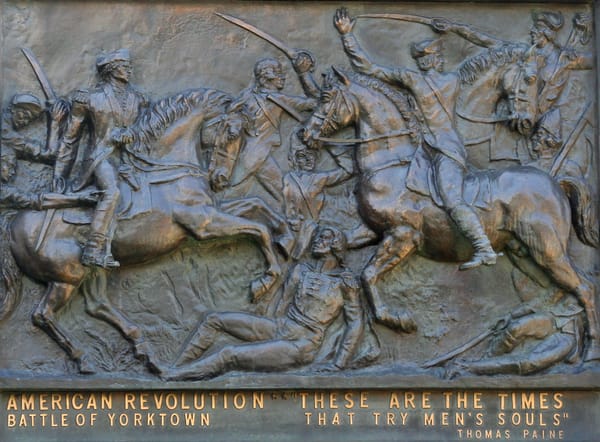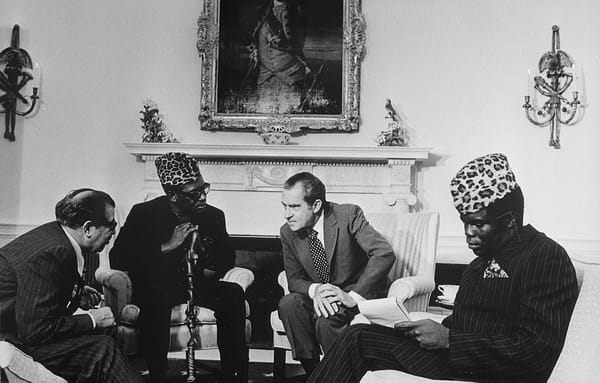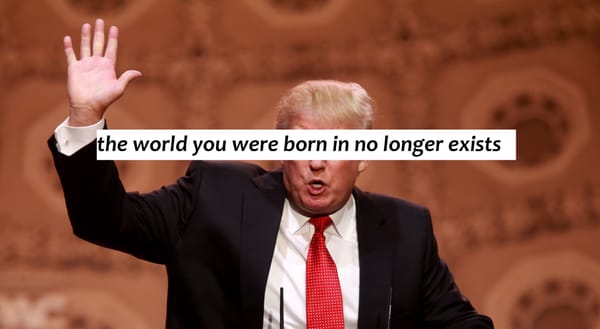Applying the Lessons of George’s Protection or Free Trade

For decades after World War Two, the signing of the Bretton Woods agreement, and the creation of the General Agreement on Tariffs and Trade, systematic removal of barriers to trade dramatically increased the role of international trade in the global economy. The economic gains were immense, and while critics pointed out failures in fairly distributing those gains, few thought this maldistribution would pose a serious challenge to the free-trade system. But in 2016, after decades of policy dominance, free trade suddenly found itself faced with major setbacks. The Brexit election in the UK and victory of Donald Trump in the US—with his promises to withdraw from the Trans-Pacific Partnership and renegotiate NAFTA—demonstrated free trade’s weakening popularity.
The situation is hardly unprecedented in US history, however. The question of tariffs in the early 19th century sparked a constitutional crisis when the state of South Carolina refused to collect a duty they labeled ‘the tariff of abominations’, and discussions of trade policy became one of the defining areas of disagreement between the Democratic and Republican parties after the Civil War.
It was with this backdrop, during a debate about tariffs on woolen goods in 1892, that Representative Tom Johnson of Ohio requested that the entirety of Henry George’s book Protectionism or Free Trade be read into the Congressional record. Johnson was a millionaire who, having read George’s work, entered politics. He was later elected mayor of Cleveland, rising to national prominence as one of the most effective Progressive mayors. The late 19th-century movement for free trade would surmount the steepest hurdle for US political reform by managing to pass a constitutional amendment allowing for an income tax, which provided revenue to replace that from tariffs. By the outbreak of World War I, these reformers had brought the tariff down to rates comparable to those seen today—victories for free trade that would be expanded upon after World War II to create the current, nearly global liberal system.
The success of George’s work as part of this popular electoral response to protectionism has lessons for today. While economic circumstances evolve over time, George’s formula for taking free trade from a textbook technocratic policy to a vital and popular ideal is still a useful guide for free traders looking to do the same thing. In shifting the emphasis towards the well-being of workers, in both tone and argument, paths are opened to broader cooperation. Even those who may not agree entirely with George’s ultimate diagnosis can learn a great deal from the way he describes the malaise infecting many free-trade arguments. Effective argument in favor of free trade must center the conditions of the working class, rather than being caught up in abstract discussions of efficiency, and must be part of a broad program that has as its goal not just a richer global system but also a freer and more equal one.
In the opening of the book, George discusses the obstacles confronting the free-trade argument shortly after the end of the Civil War. He sees free trade as suffering from both partisan obstacles and rhetorical ones. In terms of the party system, free trade was embraced primarily by the Democratic Party, while Republicans supported protective tariffs. The whole concept of free trade was sullied by its association with the Confederacy—“the men who tried to rend the Union in order to establish a nation based upon the right of capital to own labor, prohibited protection in the constitution they formed.” One might add that beyond the still-strong memories of the Civil War, the political situation was such that two groups most subject to oppression under the economic system—Black Americans, and those workers recently immigrated to the United States—were largely relegated to separate parties, stymying any effective efforts at creating a truly working-class party.
The problem George describes is familiar both rhetorically and ideologically. Many of the most ardent free traders embraced laissez-faire principles throughout the economy, and their distaste for tariffs was matched by a broad opposition to any interference in the economy by government—or by organized labor. George lays out this problem quite clearly:
The opponents of protection have, for the most part, not only professed no special interest in the well-being of the working classes and no desire to raise wages, but have denied the justice of attempting to use the powers of government for this purpose. The doctrines of free trade have been intertwined with teachings that throw upon the laws of nature responsibility for the poverty of the laboring class, and foster a callous indifference to their sufferings… While protesting against restrictions upon the production of wealth they have ignored the monstrous injustice of its distribution.
This is, sadly, a deep problem within liberal thought. Classist beliefs about the poor and a Malthusian perspective on demographics guided many early economic liberals to assume that the cause of poverty was rooted in the behavior of poor people themselves, in either their anti-social tendencies or simply their reproduction.
Here, 20th-century free traders in many ways traced the disastrous footsteps of their 19th-century forbears. Internationally, organizations such as the IMF that are dedicated to maintaining the global economic system, including advocating for freer trade, too frequently demand that countries receiving aid conform to orthodox strictures on privatization and austerity. The various elements of the ‘Washington Consensus’—free trade, privatization, and limited regulation—are so often grouped together both rhetorically or organizationally that people around the world expect for free trade to be accompanied by demands for deep cuts in government spending and privatization of infrastructure.
George’s approach is different—from the beginning, he sets out the goal of his exploration as determining the impact of free trade on wages, particularly the wages of workers who do not have the protection of unions or the advantage of hard to hire skills. This focus, coupled with George’s accessible text—sprinkled with folksy metaphors (“Protective tariffs make more work, in the sense in which…a rain that wets his hay makes more work for the farmer”) and ‘man on the street’ anecdotes—make a sharp contrast with the technocratic, statistics-heavy style of many free trade advocates. Most importantly, George provides an explanation for the continued poverty in free-trading countries (Britain especially) that does not hinge on blaming the victims of that poverty.
In George’s telling, the British working class continued to suffer from poverty and periodic unemployment despite the increased wealth brought about by free trade because they lacked a viable fallback position from paid employment. Because agricultural land was owned primarily by a small upper class, with most common land that had helped sustain independent farmers in previous generations firmly enclosed, workers were forced to seek industrial employment. There, land ownership and the growth of monopolies in manufacturing, shipping, and railroads conspired to keep wages barely above rents, even as expanded trade and exports enriched a few beneficiaries. In this narrative, poverty is not caused by poor habits and antisocial behavior but rather the reverse: a lack of prospects and the struggle for survival give rise to those behaviors. American workers managed to earn higher wages than British ones, then, because they had greater access to an independent living on free or cheap land—but this circumstance, George warned, was rapidly changing. He also specifically addressed accusations that the Irish in particular suffered from poverty because of their Catholicism, a narrative popular both in England and among American nativists—a point which, beyond appealing to his Irish Catholic wife, had relevance for George’s political activism, which relied on support from the politically well-organized Irish-American community.
Free traders today do not face precisely the same partisan challenges, but ideological and rhetorical challenges that are just as acute. In the US, free trade has found proponents (and some opponents) in both parties. However, much like the 19th-century Democrats, proponents of free trade—and particularly the organizations that look to expand their agenda, like the WTO—have found themselves under attack from a wide range of activist groups, running the gamut from right-wing conspiracy theorists to environmentalists and racial justice activists. Blunting this opposition requires that free traders explain the contribution of government privileges to the persistence of inequality, and to endorse policies that will actively reduce poverty rather than expecting the rising tide of free trade to float all boats. They must, in other words, take a “special interest in the well-being of the working-classes.”
This dedication to making free trade work for the working class is crucial because elite opinion cannot sustain free trading policies forever in the face of opposing public opinion. And shifting the course of public opinion will require a change to actual conditions as well as rhetorical re-orientation. Too often, as George alleges, “All [free trade advocates] can promise the laborer is that production shall be increased and many commodities cheapened… And when confronted by the failure of revenue reform to eradicate pauperism, the free trader of this type can make no answer that will satisfy the questioner.” George devoted his career to finding answers to that question and rallying people—especially in the working class—to reform what he saw as the root problems. For George, the answer to the question of continuing poverty in the face of advancing wealth is multifaceted, but there’s no question as to what is the largest factor: he describes a series of robbers who steal from the wages of the working class, starting with tariffs and including monopolies and corruption, but finally ending with land rents, which according to him will take whatever is left over from the other robbers.
George’s argument is compelling—and on at least a local level, readily observable. So-called ‘superstar’ cities in the US, including San Francisco and New York City, have experienced tremendous growth, much of it related to globalization and the expansion of the digital and ‘knowledge’ economies. But the higher productivity has led to skyrocketing land values and rents, while leaving levels of poverty, especially adjusted for taxes, transfers, and cost of living, still at high levels.
George’s solution—replacing taxes on productive activities and built property with taxes on land values—is an avenue free traders and other economic liberals would do well to explore. Even for those who find that answer insufficient or unsatisfactory, however, there is much to learn from George’s defense of free trade.
The first and perhaps most critical lesson for today’s free trade advocates to learn from the successful Georgist advocacy of free trade is the necessity of centering the working class in both rhetoric and policy. Where possible, trade deals should be structured in ways that are likely to raise wages or at least keep them stable while lowering prices. But that can, of course, rarely be guaranteed. Thus, trade deals whose distribution impacts are likely to benefit high earners should be coupled—both rhetorically and legislatively—with increased benefits to workers. The lesson is not to repeat the 1990s—which saw the accession of China to the WTO and the signing of NAFTA occur at nearly the same time as welfare reform was putting new pressures on the unemployed and the ‘war on crime’ was devastating Black communities. When the 1990s bubbles burst, many blamed those free-trade deals for the inequality they observed and the stagnation in median wages.
Free trade would likely also be more popular internationally if its advocates followed George’s view that it is an ideal means to expand friendly commerce and should be accompanied by demilitarization. George denounced what he saw as a two-part scam being pulled on the American people. Pressure for increased arms spending, the first part, benefitted the military and associated industries. Even in the 1880s the connection between military spending and industrial interests was clear, with behemoths like Krupp and Colt making millions on arms manufacturing. Second came increased demands for rising government revenues—demands that justified the continued existence of high tariffs and thus protected the profits of even more industries. Too often today, hawkishness in foreign policy and evangelism for free trade go hand in hand—and thus protectionists find they can sell their solution in alliance with isolationism, which has ready-made sympathetic audiences on both left and right. But nationalism and protectionism are not the natural results of a less interventionist foreign policy, and economic liberals today need to describe another possible world—one populated by a “league of sovereign States, settling their differences by a common tribunal and opposing no impediments to trade and travel…giving to the world a more than Roman peace.”
This focus on peaceful internationalism can be one of many ways free-trade liberals can find common ground with social democrats and other left-leaning groups. George’s perspective on socialism is considerate and respectful, even as he clearly has deep disagreements with socialist views on government. He writes that “while there is a truth in socialism which individualists forget, there is a school of socialists who in like manner ignore the truth there is in individualism.” Despite coming out strongly in favor of individual liberty, free trade between nations, and the ability of individuals to make and profit from investments, George’s attitude towards socialists is not dismissive. This is something many modern free traders can learn from him. Too often we as liberals assume that history has conclusively shown socialism to be a failure, and that economic theory indicates that it must always be so. But there are times when we can learn from a socialist perspective, even if our responses might differ. And a combination of the insights from the two theories can be superior to those of only one or the other. The socialist passion for eliminating poverty and instituting a living wage, for example, may seem to run contrary to liberal theory. However, empirical research has challenged the straightforward relationship between minimum wages and employment. Rather than simply re-emphasizing for the thousandth time the theory that a minimum wage is a price floor that dooms people to unemployment, free market liberals would do well to offer an alternative—potentially in the shape of universal, direct benefits to provide the same impact on poverty reduction without the same market distortions.
Another potential point of commonality with the left can come in the understanding of ‘land’ by George’s definition. Even if they do not share George’s view of land value taxation as a panacea for myriad social problems—and indeed it would be difficult to match his utopic description of its anticipated effects—any economic liberal would do well to note his differentiation between land and capital, and to help make it legible to public understandings of economics. For George, land—those resources which are not created by individual effort but are inherent to nature—cannot rightfully earn returns for its purchaser because its existence is not the result of any human effort. While most Americans do not share this view, there is something intuitively different about land that makes people who have never given a formal thought to political economy uneasy with massive landholdings and especially foreign land ownership.
For this reason, the foreign investments most likely to arouse opposition, both internationally and at home, are in what George would call land. Ownership of plantations, mines, aquifers, and oil deposits are all more likely to provoke backlash than ownership of constructed capital. The supply of these goods cannot be expanded beyond a certain point, regardless of the prices paid for them by investors. Thus these investments can more completely edge out local purchasers and cannot contribute as much to local productivity as investment in infrastructure, manufacturing capacity, or human capital can. People who are irritated to see foreigners driving up the price of land or taking ownership of it—even if they cannot put into economic terms why it chafes them, and even if the only terms in which they can express their idea are those of nationalism and populism—are fundamentally justified in reacting differently than they might to foreign direct investment in general. So rather than try to undercut these claims or overthrow governments that make them—as the US and its allies did in Guatemala, Iran, and elsewhere during the Cold War—economic liberals should do well to recognize this difference. Profiting from land and resources, as from natural and government-protected monopolies, is truly rent seeking, in the sense that it does not come from producing any real wealth for the community. When asked to explain how inequality stubbornly persists despite greater economic liberalization, free traders should be pointing directly to this ultimate cause, because in such direction lies the prospect of a political struggle that can unite the interests of capital and labor, which to a liberal mind is the proper condition for political economy. Here again those who lean towards the socialist left can find common ground with liberals—many of the generic complaints about capitalism, after all, are in fact complaints about the domination of land and the protection of natural monopolies.
George’s contemporary Mark Twain is supposed to have said that history does not repeat itself, but it does rhyme. Echoes of previous debates about economic liberalization and free trade can be heard in current debates, and the progress made by George, Johnson, and others show the value of their approach: the national debate on free trade was a major contributor to the passage of the 16th Amendment, legalizing income taxes and opening up the possibility of removing tariffs entirely. George’s Protection or Free Trade continues to present lessons for how to make the liberal side of the argument attractive to both domestic and working classes by keeping the focus on the income of wage earners, working with the left where appropriate, and keeping in mind the distinction between wealth creation and rent collection. If free trade advocates can both explain the benefits of free trade effectively and ensure those benefits are distributed to a broad cross-section of society, advocacy for free trade may again capture popular attention, and trade policy will cease to be a political weapon for protectionist populists to wield against a supposed global elite.
Featured Image is drawing of the MV Empire Galahad, by Fut.Perf




